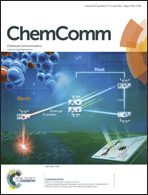Diastereomeric control of enantioselectivity: evidence for metal cluster catalysis†
Abstract
Enantioselective hydrogenation of tiglic acid effected by diastereomers of the general formula [(μ-H)2Ru3(μ3-S)(CO)7(μ-P–P*)] (P–P* = chiral Walphos diphosphine ligand) strongly supports catalysis by intact Ru3 clusters. A catalytic mechanism involving Ru3 clusters has been established by DFT calculations.


 Please wait while we load your content...
Please wait while we load your content...